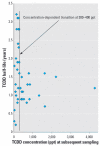Age- and concentration-dependent elimination half-life of 2,3,7,8-tetrachlorodibenzo-p-dioxin in Seveso children
- PMID: 17035149
- PMCID: PMC1626409
- DOI: 10.1289/ehp.8884
Age- and concentration-dependent elimination half-life of 2,3,7,8-tetrachlorodibenzo-p-dioxin in Seveso children
Abstract
Objective: Pharmacokinetic and statistical analyses are reported to elucidate key variables affecting 2,3,7,8-tetrachlorodibenzo-p-dioxin (TCDD) elimination in children and adolescents.
Design: We used blood concentrations to calculate TCDD elimination half-life. Variables examined by statistical analysis include age, latency from exposure, sex, TCDD concentration and quantity in the body, severity of chloracne response, body mass index, and body fat mass.
Participants: Blood was collected from 1976 to 1993 from residents of Seveso, Italy, who were < 18 years of age at the time of a nearby trichlorophenol reactor explosion in July 1976.
Results: TCDD half-life in persons < 18 years of age averaged 1.6 years while those > or =18 years of age averaged 3.2 years. Half-life is strongly associated with age, showing a cohort average increase of 0.12 year half-life per year of age or time since exposure. A significant concentration-dependency is also identified, showing shorter half-lives for TCDD concentrations > 400 ppt for children < 12 years of age and 700 ppt when including adults. Moderate correlations are also observed between half-life and body mass index, body fat mass, TCDD mass, and chloracne response.
Conclusions: Children and adolescents have shorter TCDD half-lives and a slower rate of increase in half-life than adults, and this effect is augmented at higher body burdens.
Relevance: Modeling of TCDD blood concentrations or body burden in humans should take into account the markedly shorter elimination half-life observed in children and adolescents and concentration-dependent effects observed in persons > 400-700 ppt.
Figures






References
-
- Abraham K, Geusau A, Tosun Y, Helge H, Bauer S, Brockmoller J. Severe 2,3,7,8-tetrachlorodibenzo-p-dioxin (TCDD) intoxication: insights into the measurement of hepatic cytochrome P450 1A2 induction. Clin Pharmacol Ther. 2002;72:163–174. - PubMed
-
- Agency for Toxic Substances and Disease Registry 1998. Toxicological Profile for Chlorinated Dibenzo-p-Dioxins. Atlanta, GA:Agency for Toxic Substances and Disease Registry. - PubMed
-
- Aylward LL, Brunet RC, Carrier G, Hays SM, Cushing CA, Needham LL, et al. Concentration-dependent TCDD elimination kinetics in humans: toxicokinetic modeling for moderately to highly exposed adults from Seveso, Italy and Vienna, Austria, and impact on dose estimates for the NIOSH cohort. J Exposure Anal Environ Epidemiol. 2005;15:1–15. - PubMed
-
- Carrier G, Brunet RC, Brodeur J. Modeling of the toxico-kinetics of polychlorinated dibenzo-p-dioxins and dibenzofurans in mammalians, including humans. I. Nonlinear distribution of PCDD/PCDF body burden between liver and adipose tissues. Toxicol Appl Pharmacol. 1995a;131:253–266. - PubMed
-
- Carrier G, Brune RC, Brodeur J. Modeling of the toxico-kinetics of polychlorinated dibenzo-p-dioxins and dibenzofurans in mammalians, including humans. II. Kinetics of absorption and disposition of PCDDs/PCDFs. Toxicol Appl Pharmacol. 1995b;131:267–276. - PubMed
Publication types
MeSH terms
Substances
LinkOut - more resources
Full Text Sources

